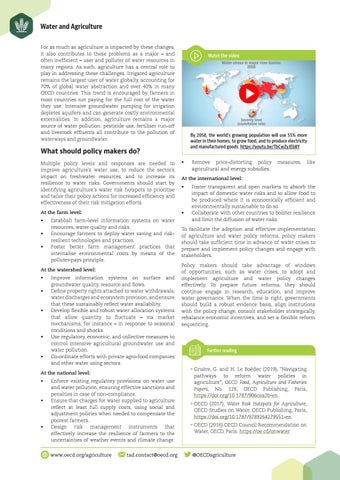Water and Agriculture For as much as agriculture is impacted by these changes, it also contributes to these problems as a major – and often inefficient – user and polluter of water resources in many regions. As such, agriculture has a central role to play in addressing these challenges. Irrigated agriculture remains the largest user of water globally, accounting for 70% of global water abstraction and over 40% in many OECD countries. This trend is encouraged by farmers in most countries not paying for the full cost of the water they use. Intensive groundwater pumping for irrigation depletes aquifers and can generate costly environmental externalities. In addition, agriculture remains a major source of water pollution: pesticide use, fertiliser run-off and livestock effluents all contribute to the pollution of waterways and groundwater.
Watch the video
By 2050, the world’s growing population will use 55% more water in their homes, to grow food, and to produce electricity and manufactured goods. https://youtu.be/TbCwZyJEb8Y
What should policy makers do? Multiple policy levels and responses are needed to improve agriculture’s water use, to reduce the sector’s impact on freshwater resources, and to increase its resilience to water risks. Governments should start by identifying agriculture’s water risk hotspots to prioritise and tailor their policy actions for increased efficiency and effectiveness of their risk mitigation efforts.
•
At the farm level:
•
• • •
Establish farm-level information systems on water resources, water quality and risks. Encourage farmers to deploy water saving and riskresilient technologies and practices. Foster better farm management practices that internalise environmental costs by means of the polluter-pays principle.
At the watershed level: • •
•
•
•
Improve information systems on surface and groundwater quality, resource and flows. Define property rights attached to water withdrawals, water discharges and ecosystem provision, and ensure that these sustainably reflect water availability. Develop flexible and robust water allocation systems that allow quantity to fluctuate – via market mechanisms, for instance – in response to seasonal conditions and shocks. Use regulatory, economic, and collective measures to control intensive agricultural groundwater use and water pollution. Co-ordinate efforts with private agro-food companies and other water using sectors.
At the national level: •
•
•
Enforce existing regulatory provisions on water use and water pollution, ensuring effective sanctions and penalties in case of non-compliance. Ensure that charges for water supplied to agriculture reflect at least full supply costs, using social and adjustment policies when needed to compensate the poorest farmers. Design risk management instruments that effectively increase the resilience of farmers to the uncertainties of weather events and climate change. www.oecd.org/agriculture
tad.contact@oecd.org
Remove price-distorting policy agricultural and energy subsidies.
measures,
like
At the international level: •
Foster transparent and open markets to absorb the impact of domestic water risks and to allow food to be produced where it is economically efficient and environmentally sustainable to do so. Collaborate with other countries to bolster resilience and limit the diffusion of water risks.
To facilitate the adoption and effective implementation of agriculture and water policy reforms, policy makers should take sufficient time in advance of water crises to prepare and implement policy changes and engage with stakeholders. Policy makers should take advantage of windows of opportunities, such as water crises, to adopt and implement agriculture and water policy changes effectively. To prepare future reforms, they should continue engage in research, education, and improve water governance. When the time is right, governments should build a robust evidence basis, align institutions with the policy change, consult stakeholder strategically, rebalance economic incentives, and set a flexible reform sequencing.
Further reading
• Gruère, G. and H. Le Boëdec (2019), “Navigating pathways to reform water policies in agriculture”, OECD Food, Agriculture and Fisheries Papers, No. 128, OECD Publishing, Paris, https://doi.org/10.1787/906cea2b-en. • OECD (2017), Water Risk Hotspots for Agriculture, OECD Studies on Water, OECD Publishing, Paris, https://doi.org/10.1787/9789264279551-en • OECD (2016) OECD Council Recommendation on Water, OECD, Paris. https://oe.cd/onwater
@OECDagriculture
